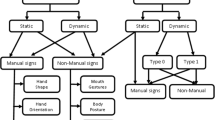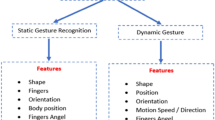Abstract
There are much heavy studies on handwritten character recognition (HCR) for nearly previous four decades. The research on some of the common script like Arabic, Indian and Chinese has been done. This manuscript presents a survey of character recognition on Arabic script, and most of the popular published paper methods are summarized and also analyzed different methods for building a robust system of HCR and included some future research on recognition direction of handwritten character. The paper analyzed and presented various algorithms with respect to preprocessing methods, segmentation methods, feature extraction methods and various classification approaches of the Arabic character recognition.






Similar content being viewed by others
References
Niu XX, Suen CY. A novel hybrid CNN–SVM classifier for recognizing handwritten digits. Pattern Recogn. 2012;45(4):1318–25.
Zeiler MD, Fergus R. Visualizing and understanding convolutional neural networks. arXiv:1311.2901. 2013.
Mesleh A, Sharadqh A, Al-Azzeh J, Abu-Zaher M, Al-Zabin N, Jaber T, Odeh A, Hasn M. An optical character recognition. Contemp Eng Sci. 2012;5(11):521–9.
Albakoor M, Saeed K, Sukkar F. Intelligent system for Arabic character recognition. In: World congress on nature & biologically inspired computing. New York; IEEE; p. 982–87. 2009.
Zaghloul RI, Alrawashdeh EF, Mohammad D, Bader K. Multilevel classifier in recognition of handwritten Arabic characters. J Comput Sci. 2011;7(4):512–8.
Ali AAA, Suresha M. A novel approach to correction of a skew at document level using an Arabic script. Int J Comput Sci Inf Technol. 2017;8(5):569–73.
Ismail SM, Norul S, Sheikh H. Online Arabic handwritten character recognition based on a rule based approach. J Comput Sci. 2012;8(11):1859–68.
Zawaideh FH. Arabic hand written character recognition using modified multi-neural network. J Emerg Trends Comput Inf Sci. 2012;3(7).
Benouareth A, Ennaji A, Sellami M. HMMs with explicit state duration applied to handwritten Arabic word recognition. In: 18th international conference on pattern recognition (ICPR’06). New York: IEEE; Vol. 2, p. 897–900, 0-7695-2521-0/06. 2006.
Cheung A, Bennamoun M, Bergmann NW. An Arabic optical character recognition system using recognition-based segmentation. Pattern Recogn. 2001;34(2):215–33.
Wang X, Huang TL, Liu XY. Handwritten character recognition based on BP neural network. In: Third international conference on genetic and evolutionary computing (WGEC’09). New York: IEEE; p. 520–24. 2009.
Alginahi YM. A survey on arabic character segmentation. Int J Docum Anal Recognit. 2002;1–22.
Casey RG, Lecolinet E. Strategies in character segmentation: a survey. Int Conf Docum Anal Recognit IEEE. 1995;2:1028–33.
Alkhateeb JH, Jiang J, Ren J, Ipson S. Component-based segmentation of words from handwritten Arabic text. Int J Comput Syst Sci Eng. 2009;5(1):54–8.
Zeki AM. The segmentation problem in Arabic character recognition the state of the art. In: First international conference on information and communication technologies (ICICT). New York: IEEE; p. 11–26, 0-7803-9421-6/05. 2005.
Cowell J, Hussain H. Thinning Arabic characters for feature extraction. In: International conference on information visualization. New York: IEEE; p. 181–185. 2001.
Al-Sadoun H, Amin A. A new structural technique for recognizing printed Arabic text. Int J Pattern Recognit Artif Intell. 1995;9(1):101–25.
Suresha M, Ali AAA. Segmentation of handwritten text lines with touching of line. Int J Comput Eng Appl. 2018;12(6):1–12.
Hamid A, Haraty R. A neuro-heuristic approach for segmenting handwritten Arabic text. In: International conference on computer systems and applications. p. 110–13. 2001.
Ali AAA, Suresha M. An efficient character segmentation algorithm for recognition of Arabic handwritten script. In: International conference on data science and communication. New York: IEEE; 978-1-5386-9319-3/19/$31.00 ©2019. 2019.
Al-Ma’adeed S. Recognition of off-line handwritten Arabic words. PhD Thesis, University of Nottingham. 2004.
Alhamad HA. Use an efficient neural network to improve the Arabic handwriting recognition. In: International conference on signal and image processing applications (ICSIPA). New York: IEEE; p. 269–74. 2013.
Aljuaid H, Muhammad Z, Sarfraz M. A tool to develop Arabic handwriting recognition system using genetic approach. J Comput Sci. 2010;6(6):619–24.
Almohri H, Gray JS, Alnajjar H. A real-time DSP-based optical character recognition system for isolated Arabic characters using the TI TMS320C6416T. In: Proceedings of the IAJC-IJME international conference ISBN 978-1-60643-379-9. 2008.
Amin A, Mari J. Machine recognition and correction of printed Arabic text. IEEE Trans Syst Man Cybern. 1989;19(5):1300–6.
Khorsheed MS, Clocksin WF. Structural features of cursive Arabic script. In: Proceedings of tenth British machine vision conference (BMVC). p. 422–31. 1999.
Srinivasan GN, Shobha G. Statistical texture analysis. Proc World Acad Sci Eng Technol. 2008;36:1264–9.
Abdullah MA, Al-Harigy LM, Al-Fraidi HH. Off-line Arabic handwriting character recognition using word segmentation. J Comput. 2012;4(3):40–4.
Abed MA, Abed AL-Asadi HA, Baha Al-Deen ZS, Ismail AN. Fuzzy logic approach to recognition of isolated Arabic characters. Int J Comput Theory Eng. 2010;2(1):119–24.
Khedher MZ, Al-Talib G. Recognition of secondary characters in handwritten Arabic using Fuzzy Logic. In: International conference on machine intelligence. 2005.
Sarfraz M, Al-Awami ATA. Arabic character recognition using particle swarm optimization with selected and weighted moment invariants. In: 9th international symposium on signal processing and its applications (ISSPA). New York: IEEE; p. 1–4, 1-4244-0779-6/07. 2007.
Amor NB, Amara NB. Combining a hybrid approach for features selection and hidden Markov models in multifont Arabic characters recognition. In: IEEE second international conference on document image analysis for libraries 0-7695-2531-8/06. 2006.
Abandah GA, Younis KS, Khedher MZ. Handwritten Arabic character recognition using multiple classifiers based on letter form. In: International conference on signal processing, pattern recognition, & applications. p. 128–33. 2008.
Hachour O. The combination of fuzzy logic and expert system for Arabic character recognition. In: 3rd international IEEE conference intelligent systems. p. 189–191. 2006.
Mohiuddin KM, Mao J. A comparative study of different classifiers for handprinted character recognition. Mach Intell Pattern Recogn. 1994;16:437–48.
Alkhateeb JH. Word based off-line handwritten Arabic classification and recognition. PhD Thesis, Computing School, Informatics and Media, Bradford University. 2010.
AlKhateeb JH, Ren J, Jiang J, Ipson SS, El-Abed H. Word-based handwritten Arabic scripts recognition using DCT features and neural network classifier. In: 5th international multi-conference on systems, signals and devices. New York: IEEE; p. 1–5. 2008.
Ben Amor N, Ben Amara NE. Multifont Arabic characters recognition using hough transform and HMM/ANN classification. J Multi-media. 2006;1(2):50–4.
Khorsheed MS, Clocksin WF. Multi-font Arabic word recognition using spectral features. Int Conf Pattern Recognit. 2000;4:543–6.
Jannoud IA. Automatic Arabic handwritten text recognition system. Am J Appl Sci. 2007;4:857–64.
Ali AAA, Suresha M. Efficient algorithms for text lines and words segmentation for recognition of Arabic handwritten script. Emerging research in computing., Information, Communication and ApplicationsSingapore: Springer; 2019. p. 387–401.
Siddharth KS, Jangid M, Dhir R, Rani R. Handwritten Gurmukhi character recognition using statistical and background directional distribution features. Int J Comput Sci Eng. 2011;3(6):2332–45.
Parvez MT, Mahmoud SA. Offline Arabic handwritten text recognition: a survey. ACM Comput Surv. 2013;45(2):23.
Alimi AM. A neuro-fuzzy approach to recognize Arabic handwritten characters. Int Conf Neural Netw IEEE. 1997;3:1397–400.
Alimi AM. An evolutionary neuro-fuzzy approach to recognize on-line Arabic handwriting. Int Conf Docum Anal Recognit IEEE. 1997;1:382–6.
AlKhateeb JH, Ren J, Jiang J, Al-Muhtaseb H. Offline handwritten Arabic cursive text recognition using hidden markov models and re-ranking. Pattern Recogn Lett. 2011;32(8):1081–8.
Likforman-Sulem L, Mohammad RAH, Mokbel C, Menasri F, Bianne-Bernard AL, Kermorvant C. Features for HMM-based Arabic handwritten word recognition systems. In: Guide to OCR for Arabic scripts. London: Springer; p. 123–43. 2012.
Ahmed I, Mahmoud SA, and Parvez MT. Printed Arabic text recognition. Springer, In: Guide to OCR for Arabic scripts. p. 147–68. 2012.
Nemouchi S, Meslati S, Farah N. Classifiers combination for Arabic words recognition: application to handwritten Algerian city names. In: International conference on image and signal processing. Berlin: Springer; p. 562–70. 2012.
Pechwitz M, El Abed H, Märgner V. Handwritten Arabic word recognition using the IFN/ENIT-Database. In: Guide to OCR for Arabic scripts. Berlin: Springer; p. 169–213. 2012.
Moradi M, Poormina MA, Razzazi F. FPGA implementation of feature extraction and MLP neural network classifier for Farsi handwritten digit recognition. In: UKSim European symposium on computer modeling and simulation. New York: IEEE; p. 231–34. 2009.
Alaei A, Nagabhushan P, Pal U. A new two-stage scheme for the recognition of Persian handwritten characters. In: International conference on frontiers in handwriting recognition (ICFHR). New York: IEEE; p. 130–35. 2010.
El Abed H, Margner V. Comparison of different preprocessing and feature extraction methods for offline recognition of handwritten Arabic words. In: 9th international conference on document analysis and recognition, New York: IEEE; vol. 2, p. 974–78. 2007.
Lawal IA, Abdel-Aal RE, Mahmoud SA. Recognition of handwritten Arabic (Indian) numerals using Freeman’s chain codes and abductive network classifiers. International conference on pattern recognition. New York: IEEE; p. 1884–87. 2010.
Kessentini Y, Paquet T, Hamadou AB. Multi-stream Markov models for Arabic handwriting recognition. In: Guide to OCR for Arabic scripts, Berlin: Springer. p. 335–50. 2012.
Bayoudh S, Mouchere H, Miclet L, Anquetil E. Learning a classifier with very few examples: analogy based and knowledge based generation of new examples for character recognition. In: European conference on machine learning. Berlin: Springer; p. 527–34. 2007.
Lee CC, Shih CY, Yu CC, Lai WR, Jeng BS. Vision-based fingertip-writing character recognition. Int Signal Process Syst. 2011;64(3):291–303.
Hasan H, Haron H, Hashim SZ. Freeman Chain Code extraction using differential evolution (DE) and particle swarm optimization (PSO). In: International conference of soft computing and pattern recognition. New York: IEEE; p. 77–81. 2009.
Author information
Authors and Affiliations
Corresponding author
Ethics declarations
Conflict of Interest
The authors declare that they have no conflict of interest.
Additional information
Publisher's Note
Springer Nature remains neutral with regard to jurisdictional claims in published maps and institutional affiliations.
This article is part of the topical collection “Advances in Computational Approaches for Artificial Intelligence, Image Processing, IoT and Cloud Applications” guest edited by Bhanu Prakash K N and M. Shivakumar.
Rights and permissions
About this article
Cite this article
Ali, A.A.A., Suresha, M. & Ahmed, H.A.M. A Survey on Arabic Handwritten Character Recognition. SN COMPUT. SCI. 1, 152 (2020). https://doi.org/10.1007/s42979-020-00168-1
Received:
Accepted:
Published:
DOI: https://doi.org/10.1007/s42979-020-00168-1




